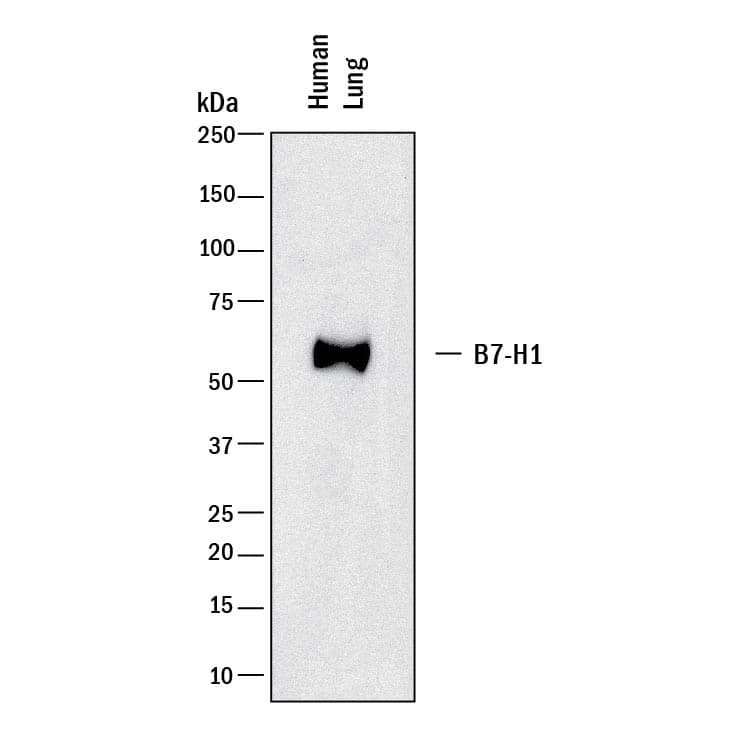Human PD-L1/B7-H1 Antibody
R&D Systems, part of Bio-Techne | Catalog # MAB1562
Recombinant Monoclonal Antibody.


Conjugate
Catalog #
Key Product Details
Species Reactivity
Human
Applications
Blockade of Receptor-ligand Interaction, CyTOF-ready, Flow Cytometry, Neutralization, Western Blot
Label
Unconjugated
Antibody Source
Recombinant Monoclonal Rabbit IgG Clone # 2340D
Product Specifications
Immunogen
Mouse myeloma cell line, NS0-derived human PD-L1/B7-H1 protein
Phe19-Thr239
Accession # Q9NZQ7
Phe19-Thr239
Accession # Q9NZQ7
Specificity
Detects human PD-L1/B7-H1 in direct ELISAs.
Clonality
Monoclonal
Host
Rabbit
Isotype
IgG
Scientific Data Images for Human PD-L1/B7-H1 Antibody
Detection of human PD-L1/B7-H1 by Western Blot.
Western blot shows lysates of human lung tissue. PVDF membrane was probed with 2 µg/mL of Rabbit Anti-Human PD-L1/B7-H1 Monoclonal Antibody (Catalog # MAB1562) followed by HRP-conjugated Anti-Rabbit IgG Secondary Antibody (Catalog # HAF008). A specific band was detected for PD-L1/B7-H1 at approximately 50 kDa (as indicated). This experiment was conducted under reducing conditions and using Immunoblot Buffer Group 1.Detection of PD-L1/B7-H1 in HEK293 Human Cell Line Transfected with Human PD-L1/B7-H1 and eGFP by Flow Cytometry.
HEK293 human embryonic kidney cell line transfected with either (A) human PD-L1/B7-H1 or (B) irrelevant protein and eGFP was stained with Rabbit Anti-Human PD-L1/B7-H1 Monoclonal Antibody (Catalog # MAB1562) followed by APC-conjugated Goat anti-Rabbit IgG Secondary Antibody (F0111). Quadrant markers were set based on Rabbit IgG control antibody staining (MAB1050). View our protocol for Staining Membrane-associated Proteins.PD-1 binding to Human PD-L1/B7-H1-transfected HEK293 Human Cell Line is Blocked by Human PD-L1/B7-H1 Antibody.
In a functional flow cytometry test, Recombinant Human PD-1 His-tagged protein (8986-PD, 500 ng/mL) binds to HEK293 human embryonic kidney cell line transfected with recombinant human PD-L1/B7-H1. (A) Binding is completely blocked by 2.5 µg/mL of Rabbit Anti-Human PD-L1/B7-H1 Monoclonal Antibody (MAB1562) but not by (B) Rabbit IgG Isotype Control (MAB1050). Ligand binding was detected by staining cells with Anti-His tag APC-conjugated Monoclonal Antibody (IC1050A).Applications for Human PD-L1/B7-H1 Antibody
Application
Recommended Usage
Blockade of Receptor-ligand Interaction
In a functional flow cytometry test, 2.5 μg/mL of Rabbit anti-human PD-L1/B7-H1 Antibody(Catalog # MAB1562) will block the binding of Recombinant Human PD-1 His-tagged protein (Catalog # 8986-PD) to HEK293 human embryonic kidney cell line transfected with recombinant human PD-L1/B7-H1.
CyTOF-ready
Ready to be labeled using established conjugation methods. No BSA or other carrier proteins that could interfere with conjugation.
Flow Cytometry
0.25 µg/106 cells
Sample: HEK293 Human Cell Line Transfected with Human PD-L1/B7-H1 and eGFP
Sample: HEK293 Human Cell Line Transfected with Human PD-L1/B7-H1 and eGFP
Western Blot
2 µg/mL
Sample: Human Lung Tissue
Sample: Human Lung Tissue
Neutralization
In a functional ELISA binding assay, 0.2-1.2 µg/mL of this
antibody will block 50% of the binding of 1 µg/mL of Recombinant Human
PD-L1/B7-H1 (Catalog # 156-B7) to immobilized Recombinant Human PD-1 Fc chimera (Catalog # 1086-PD) coated at 100 ng/mL (100 µL/well). At 2-3 µg/mL, this antibody
will block >90% of the binding.
Formulation, Preparation, and Storage
Purification
Protein A or G purified from cell culture supernatant
Reconstitution
Reconstitute at 0.5 mg/mL in sterile PBS. For liquid material, refer to CoA for concentration.
Formulation
Lyophilized from a 0.2 μm filtered solution in PBS with Trehalose. *Small pack size (SP) is supplied either lyophilized or as a 0.2 µm filtered solution in PBS.
Shipping
Lyophilized product is shipped at ambient temperature. Liquid small pack size (-SP) is shipped with polar packs. Upon receipt, store immediately at the temperature recommended below.
Stability & Storage
Use a manual defrost freezer and avoid repeated freeze-thaw cycles.
- 12 months from date of receipt, -20 to -70 °C as supplied.
- 1 month, 2 to 8 °C under sterile conditions after reconstitution.
- 6 months, -20 to -70 °C under sterile conditions after reconstitution.
Background: PD-L1/B7-H1
inflammatory-activated immune cells including macrophages, T cells, and B cells (4-7), keratinocytes (8, 9), enothelial and intestinal epithelial cells (8, 10), as well as a variety of carcinomas and melanoma (11, 12). B7-H1 binds to T cell B7-1/CD80 and PD-1 (7, 8, 12-15). It suppresses T cell activation and proliferation (5, 8, 14, 16) and induces the apoptosis of activated T cells (11). It plays a role in the development of immune tolerance by promoting T cell anergy (7, 14) and enhancing regulatory T cell development (16). B7-H1 favors the development of anti-inflammatory IL-10 and IL-22 producing dendritic cells (5, 10) and inhibits the development of Th17 cells (16). In cancer, B7-H1 provides resistance to T cell mediated lysis, enhances EMT, and enhances the tumorigenic function of Th22 cells (6, 9, 12, 15).
References
- Ceeraz, S. et al. (2013) Trends Immunol. 34:556.
- Dong, H. et al. (1999) Nat. Med. 5:1365.
- Frigola, X. et al. (2011) Clin. Cancer Res. 17:1915.
- Tamura, H. et al. (2001) Blood 97:1809.
- Chen, L. et al. (2007) J. Immunol. 178:6634.
- Kuang, D.-M. et al. (2014) J. Clin. Invest. 124:4657.
- Tsushima, F. et al. (2007) Blood 110:180.
- Mazanet, M.M. and C.C.W. Hughes (2002) J. Immunol. 169:3581.
- Cao, Y. et al. (2010) Cancer Res. 71:1235.
- Scandiuzzi, L. et al. (2014) Cell Rep. 6:625.
- Dong, H. et al. (2002) Nat. Med. 8:793.
- Azuma, T. et al. (2008) Blood 111:3635.
- Butte, M.J. et al. (2008) Mol. Immunol. 45:3567.
- Park, J.-J. et al. (2010) Blood 116:1291.
- Ritprajak, P. et al. (2010) J. Immunol. 184:4918.
- Herold, M. et al. (2015) J. Immunol. 195:3584.
Long Name
Programmed Death Ligand 1
Alternate Names
B7-H1, B7H1, CD274, PDCD1L1, PDCD1LG1, PDL1
Entrez Gene IDs
Gene Symbol
CD274
UniProt
Additional PD-L1/B7-H1 Products
Product Documents for Human PD-L1/B7-H1 Antibody
Product Specific Notices for Human PD-L1/B7-H1 Antibody
For research use only
